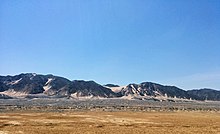Itbay


Itbāy (
Geology
The Red Sea Hills are composed of the exposed Neoproterozoic volcano-sedimentary rock of the Arabian-Nubian Shield. Although the rock itself is 550–900 million years old, the mountains were created by uplift when the Red Sea itself was formed in the Oligocene, only some 23–34 million years ago. The Red Sea Hills are thus part of the same formation as the Sarawat Mountains of Saudi Arabia and the mountains of the Sinai Peninsula.[2] The Red Sea Hills rise almost to 3,000 metres (9,800 ft) today, but in the past were much higher. The Oligocene uplift caused the rejuvenation of their streams and the increased erosion removed most of the limestone and sandstone to expose the basement layer.[3]
The Itbāy is arid, receiving less than 200 millimetres (7.9 in) of rainfall each year with high variability.
History
In prehistoric times, the Red Sea Hills were likely the area where the Proto-Cushitic language was spoken.[6]
The Red Sea Hills are a source of porphyry, which was being mined as early as the fourth millennium BC.[7]
The Red Sea Hills are inhabited by the
References
- ^ "Itbāy", in Encyclopædia Britannica (online 7 May 2012), accessed 31 December 2018.
- ^ M. Sultan, S. Sefry and M. AbuAbdallah, "Impacts of Climate Change on the Red Sea Region and its Watersheds, Saudi Arabia", The Red Sea: The Formation, Morphology, Oceanography and Environment of a Young Oceanic Basin (Springer, 2015), p. 364.
- ^ Bonnie M. Sampsell, The Geology of Egypt: A Traveler's Handbook (American University in Cairo Press, 2003), pp. 27–28.
- ^ a b Leif Manger, Managing pastoral adaptations in the Red Sea Hills of the Sudan: Challenges and Dilemmas (IIED, 1994), p. 2.
- ^ W. Bosworth, "Geological Evolution of the Red Sea: Historical Background, Review, and Synthesis", The Red Sea: The Formation, Morphology, Oceanography and Environment of a Young Oceanic Basin (Springer, 2015), p. 50.
- ISBN 978-1-315-43400-1.
- ^ a b David N. Edwards, The Nubian Past: An Archaeology of the Sudan (Routledge, 2004), pp. 64, 209, 251–52.
